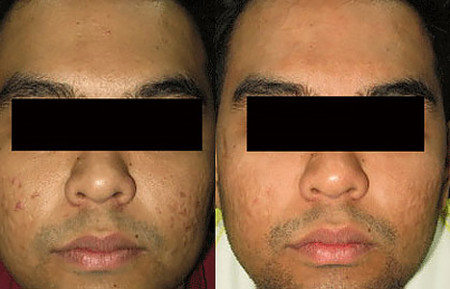How to fade dark spots in darker skin tones
Have you tried treating dark spots on your own without getting the results you want? Do you see new dark spots appear as others fade?
If you answered yes, you’re not alone. Darks spots and patches rank as one of the most common reasons that people who have darker skin tones see a dermatologist. The medical name for one cause of these dark spots is post-inflammatory hyperpigmentation. Some people just call it hyperpigmentation for short.
Before and after treatment for dark spots
His dermatologist used laser therapy and prescription-strength hydroquinone cream to even out his skin tone in 8 weeks.

Getting rid of hyperpigmentation begins with finding out why you get these dark spots or patches. If you can eliminate the cause, many spots will clear on their own and you can prevent new ones from appearing.
What causes hyperpigmentation?
People who have medium to dark skin tones get dark spots and patches because something triggers their skin to make extra melanin, the substance that gives skin its color. Many everyday things can trigger extra melanin in people who have darker skin tones.
Dark spots and patches often appear when:
A pimple or patch of psoriasis clears.
A wound caused by an insect bite, cut, burn, or other injury heals.
You take (or apply) certain medications.
A skin or hair care product irritates your skin.
Hormonal changes occur, such as during pregnancy.
How do you treat hyperpigmentation in darker skin tones?
Treatment depends upon what’s causing your hyperpigmentation. The following explains the treatment for each cause:
A skin condition like acne, eczema, or psoriasis: To get rid of hyperpigmentation caused by a skin condition, you must effectively treat the skin condition first. When the breakouts or flare-ups stop, you get rid of what’s causing the hyperpigmentation.
Most dark spots will then fade on their own over time, but it may take a long time.
Skin injury: As the wound heals, you may see a dark spot or patch. In time, the hyperpigmentation will fade if you don’t re-injure your skin.
Skin care product: When a skin or hair care product irritates your skin, the product can cause dark spots on your skin.
If you're seeing dark spots, try using gentler products. They're less likely to irritate your skin.
Products that are gentle on the skin are often labeled "for sensitive skin." You may also see "fragrance-free" on the label.
When your skin is no longer irritated, new dark spots tend to stop appearing and existing spots often clear on their own over time.
Some medications can cause dark spots
Don’t stop taking medication, even if you think it’s causing dark spots on your skin. That could make you very sick. Ask the doctor who prescribed the medication if discolored skin is a possible side effect. If it is, ask if you could switch to another medication.

How long does it take for hyperpigmentation to fade?
Once what’s causing the dark spots or patches is found and stopped, fading can take time. A spot that is a few shades darker than your natural skin color will usually fade within 6 to 12 months.
If the color lies deep in your skin, however, fading can take years. Discoloration that lies deep in the skin is often slate blue to gray in color. It may also be brown, but the brown is much darker than your natural skin color.
Treatment can speed up the fading of dark spots and patches.
What treatments do dermatologists recommend for hyperpigmentation?
Effective treatment for dark spots and patches begins with sunscreen.
To get the protection you need to prevent (and help clear) dark spots, use tinted sunscreen with iron oxide. Iron oxide helps to protect your skin from the sun's visible light (a cause of dark spots). Along with iron oxide, your tinted sunscreen should also offer all the following:
SPF 30 or higher
Broad-spectrum protection
Water-resistance
Non-comedogenic (won’t clog pores) formula if you have oily skin
The ability to blend with your skin tone (avoids a white cast)
How to find out whether a tinted sunscreen contains iron oxide
Look for iron oxide within the list of inactive ingredients. Iron oxide is considered an inactive ingredient because only ingredients that protect your skin from the sun’s harmful ultraviolet (UV) rays are listed as active ingredients. Since iron oxide protects skin from visible light rather than UV light, it’s listed as an inactive ingredient.

Sunscreen is essential. You want to apply it before going outside to all skin that clothing won’t cover. When used this way, sunscreen can prevent new dark spots and patches. It can also help to clear existing ones.
To get the best result, dermatologists also recommend wearing a wide-brimmed hat while you’re outside.
Use a product that can even out your skin tone
Once you eliminate what’s causing the dark spots and protect your skin from sunlight, a product that can fade dark spots (or even out your skin tone) tends to be more effective.
You may have success with a product that you can buy without a prescription. If you choose this option, use a product that contains one of the following ingredients:
Azelaic acid
Glycolic acid
Kojic acid
Retinoid (retinol, tretinoin, adapalene gel, or tazarotene)
Vitamin C
These ingredients can fade existing dark spots. In some cases, the ingredient can also slow down production of melanin, which is what causes the dark spots and patches.
Some products that fade dark spots do more harm than good
When buying a product that can fade dark spots, you want to choose carefully. Some products contain ingredients that can be very harmful to your skin and your health.
Researchers have found steroids or mercury, which weren’t listed on the product’s label, in skin care products imported from other countries.
The steroids in these products can cause pimples and rashes. If you unknowingly apply it to your skin for a long time, the steroids can cause your skin to become thin and fragile or permanently discolored.
To protect your health, you want to buy a product made in the United States or one recommended by your dermatologist.
Never use liquid bleach
Liquid bleach is a harmful treatment for removing dark spots and patches. You should never apply it to your skin.

Is hyperpigmentation curable?
While you can get rid of the dark spots and patches, new ones can form.
Even though you cannot cure all forms of hyperpigmentation, you can prevent it from developing again. Here’s what dermatologists recommend:
Apply your sunscreen every two hours, and after swimming or sweating.
When outdoors, wear a wide-brimmed hat.
Try to avoid being outdoors when the sun is strongest, which is between 10 a.m. and 2 p.m.
Use skin care products that are gentle on your skin. If a product burns or stings when you apply it, stop using it.
Continue to address the cause of the dark spots. For example, if you have a skin condition, continue to treat the skin condition.
How a dermatologist can help with hyperpigmentation
If the treatment you’re using fails to deliver the results you want, you may want to see a dermatologist. Dark spots and patches can be a challenge to treat. To get rid of some dark spots or patches, you may need a prescription-strength treatment.
A dermatologist has the knowledge and expertise to safely combine treatments to help you get the best results.
Related AAD resources
Images
Image 1: Used with permission of Journal of the American Academy of Dermatology: J Am Acad Dermatol. 2010;63:274-83.
Images 2-4: Getty Images
References
Heath CR and Taylor SC. “Postinflammatory hyperpigmentation.” In: Kelly AP, Taylor SC. Dermatology for Skin of Color. McGraw Hill Medical, New York, 2009:337-340.
Manuskiatti W, Triwongwaranat D, et al. “Efficacy and safety of a carbon-dioxide ablative fractional resurfacing device for treatment of atrophic acne scars in Asians.” J Am Acad Dermatol. 2010;63(2):274-83.
Roberts WE. “Melasma.” In: Kelly AP, Taylor SC. Dermatology for Skin of Color. McGraw Hill Medical, New York, 2009:332-6.
Written by:
Paula Ludmann, MS
Reviewed by:
Crystal Aguh, MD, FAAD
Erin Ducharme, MD, FAAD
Nada Elbuluk, MD, FAAD
Henry Lim, MD, FAAD
Shari Lipner, MD, PhD, FAAD
Benjamin Stoff, MD, FAAD
Last updated: 3/10/25
All content solely developed by the American Academy of Dermatology
The American Academy of Dermatology gratefully acknowledges support from the following companies:
 Atopic dermatitis: More FDA-approved treatments
Atopic dermatitis: More FDA-approved treatments
 Biosimilars: 14 FAQs
Biosimilars: 14 FAQs
 How to trim your nails
How to trim your nails
 Relieve uncontrollably itchy skin
Relieve uncontrollably itchy skin
 Fade dark spots
Fade dark spots
 Untreatable razor bumps or acne?
Untreatable razor bumps or acne?
 Tattoo removal
Tattoo removal
 Scar treatment
Scar treatment
 Free materials to help raise skin cancer awareness
Free materials to help raise skin cancer awareness
 Dermatologist-approved lesson plans, activities you can use
Dermatologist-approved lesson plans, activities you can use
 Find a Dermatologist
Find a Dermatologist
 What is a dermatologist?
What is a dermatologist?






